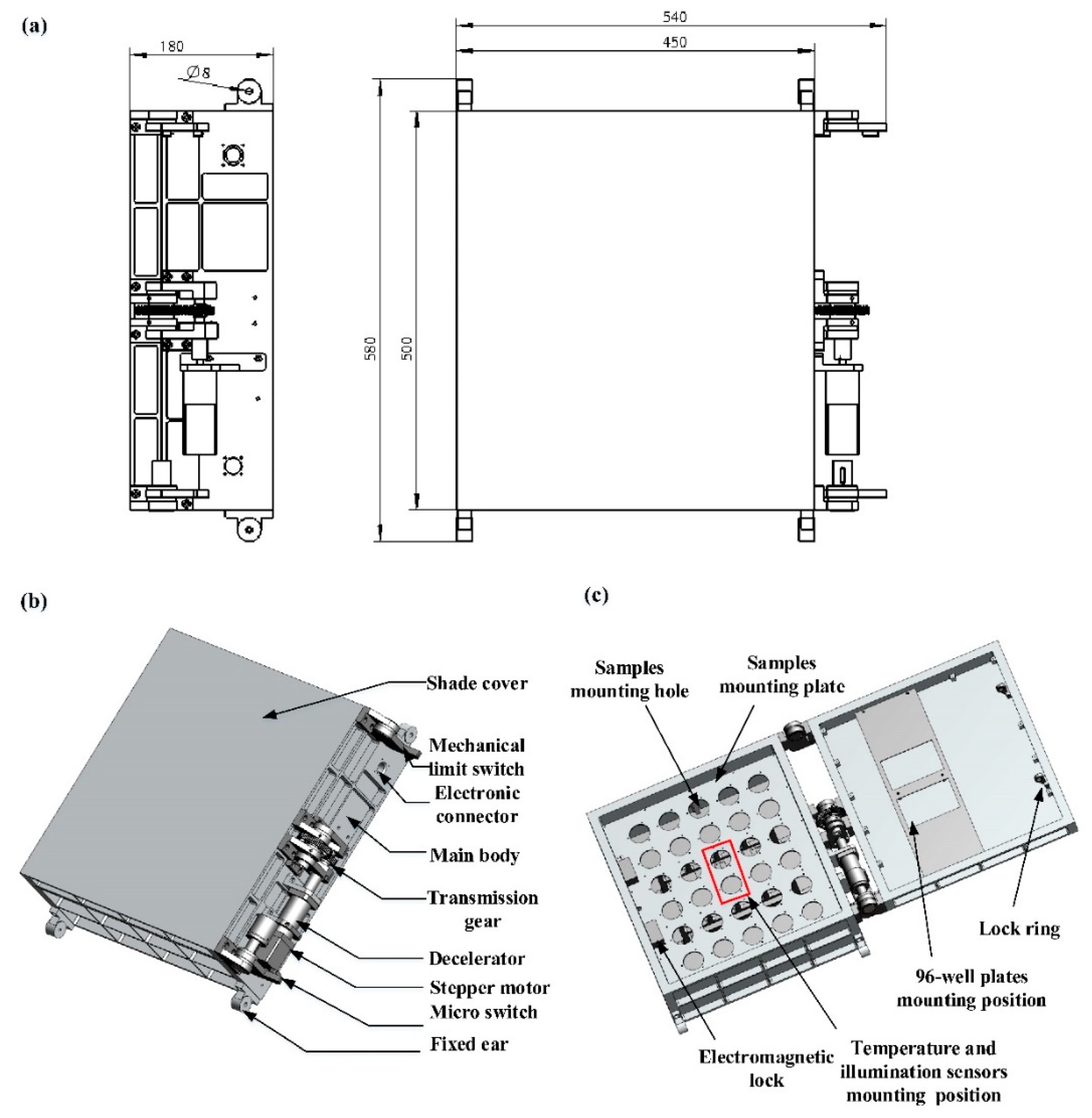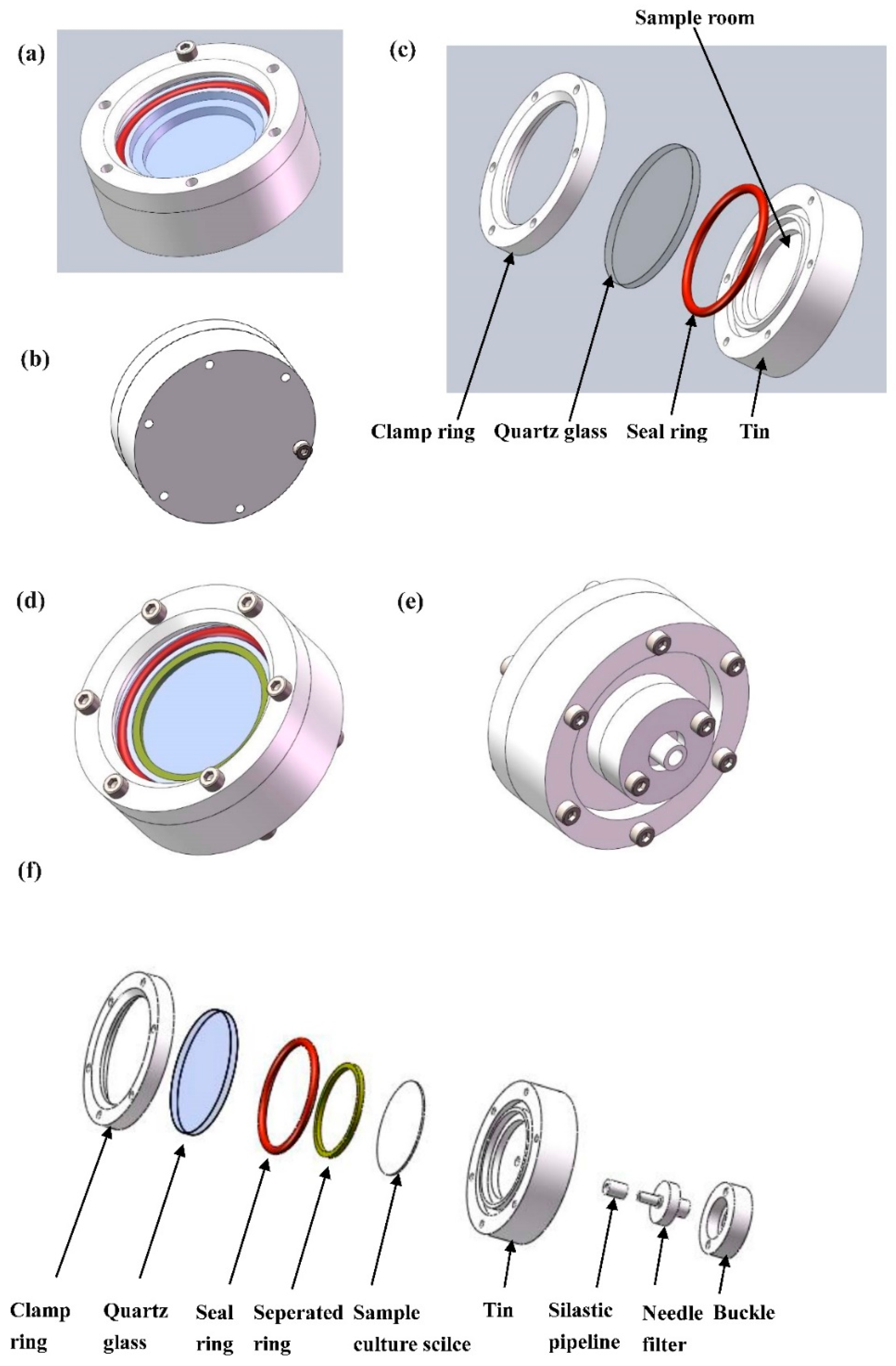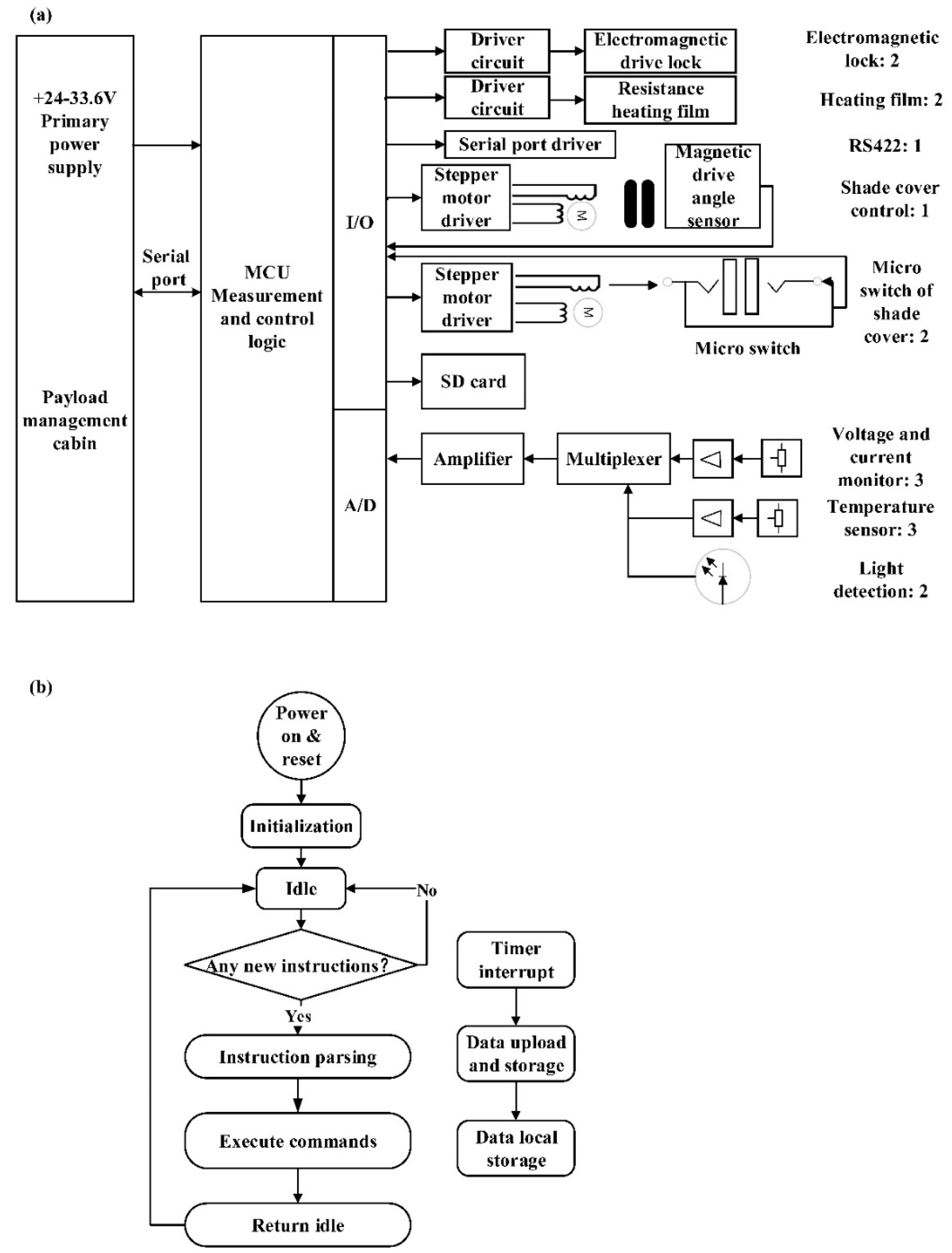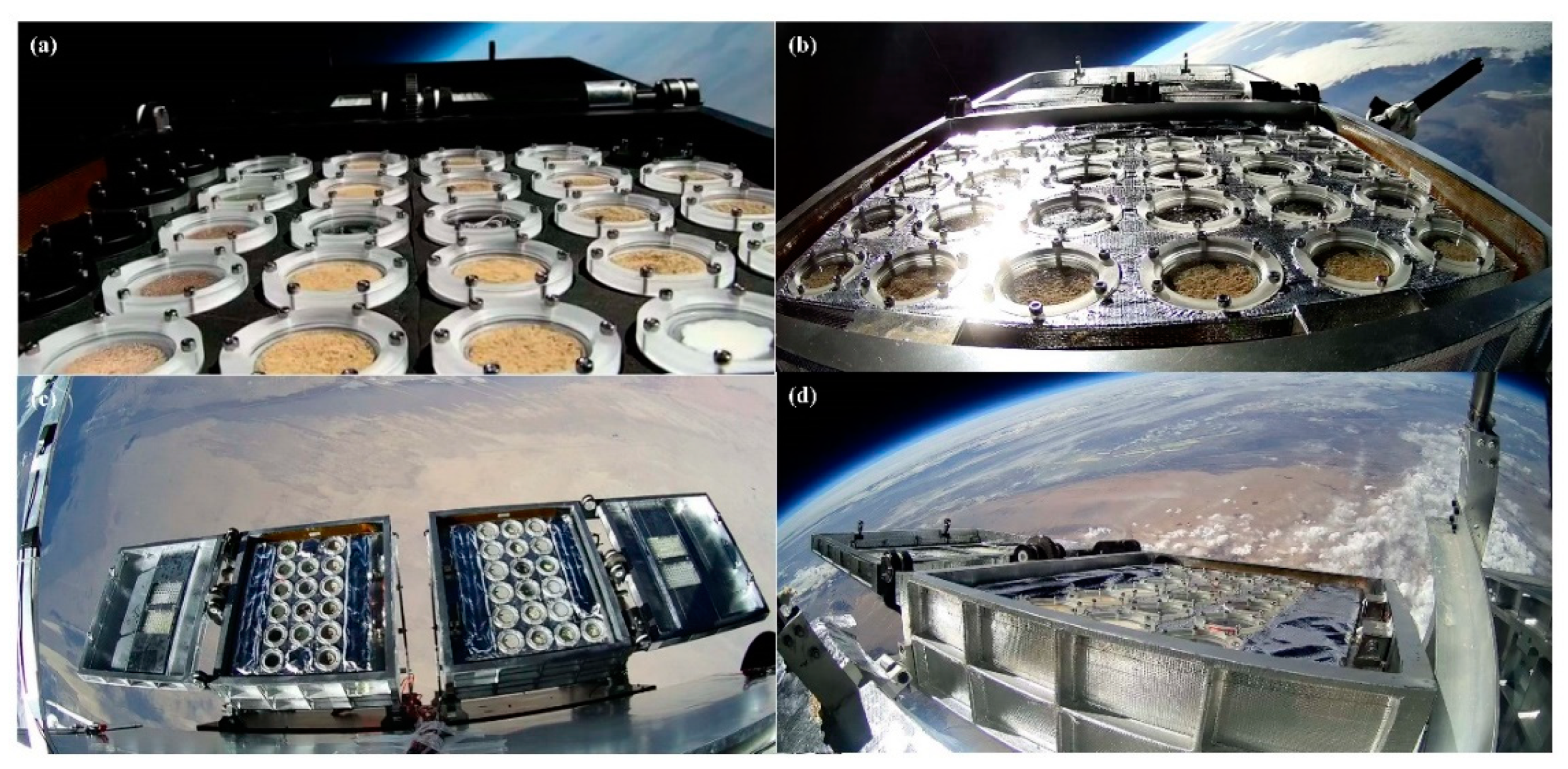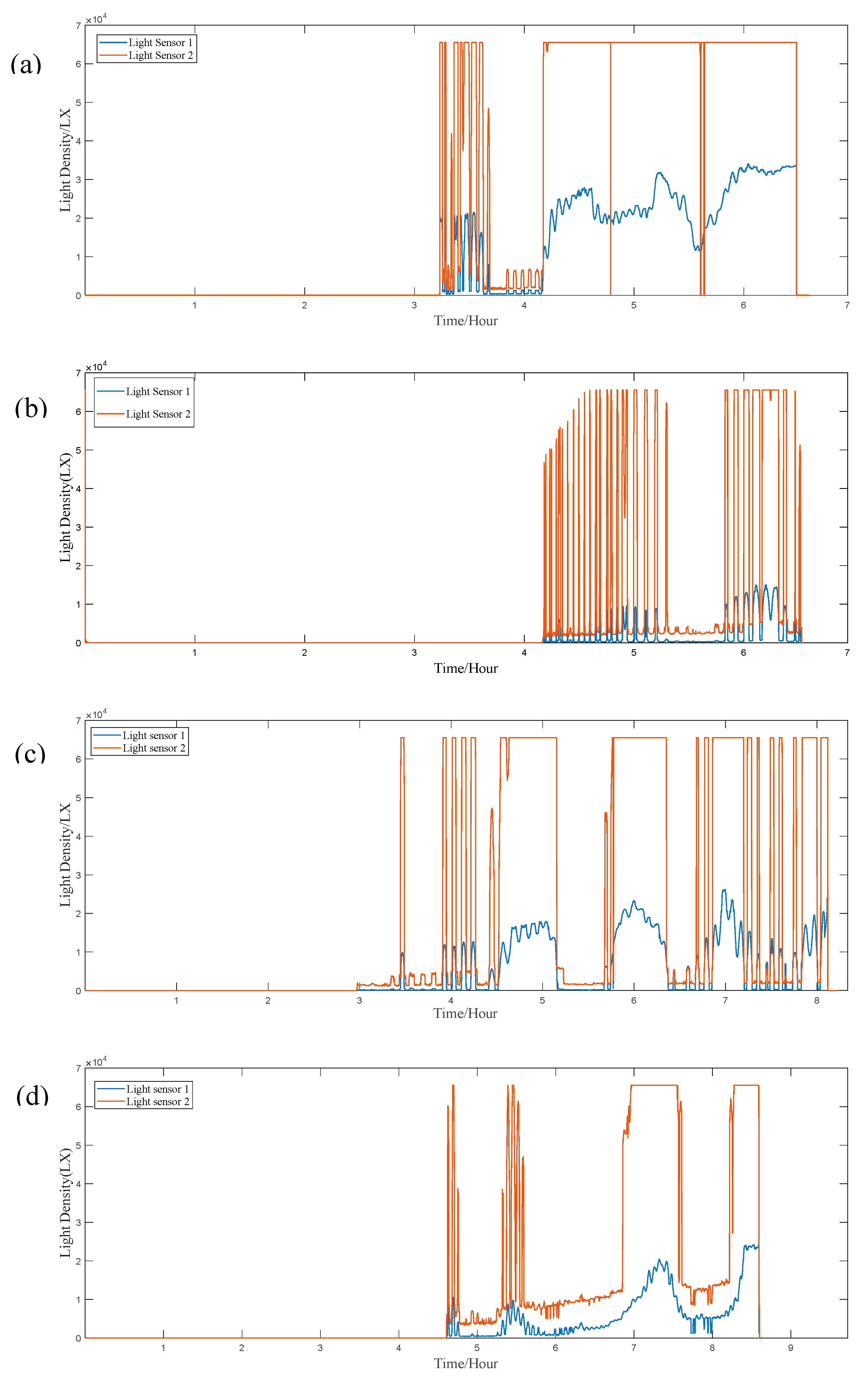1. Introduction
Earth’s near space is located in the region of 20km to 100 km above sea level (ASL), which is characterized by low temperature, low atmospheric pressure, harsh radiation, and extreme dryness [
1]. In the region of near space between 30-40 km ASL named stratosphere, which has an environment composed complicated extremely harsh conditions, and is quite resemble to the environment of Mars and Venus. Research based on scientific balloon platforms originated in the eighteenth century, mainly serving the disciplines in astronomy, astrophysics, atmospheric science [
2]. Next century, high-altitude balloon based biological exploratory research begun to extend [
3]. Although there is no microgravity environment in near space, and extreme environmental conditions in near space are also available in near earth orbit (NEO) and deep space orbit (DSO), space experiments have the weakness of expensive, and experimental opportunities are scare, and there are constraints on the weight and power consumption of scientific payloads. It is also difficult to simulate these combinations of environmental conditions on the ground. Therefore, balloon-based platforms for near-space research are particularly important. The reliability of scientific payloads and the adaptability of biological samples for survival can be studied in near space to validating the research on NEO and DSO exploration. Moreover, for both space biologists and astrobiologists, multiple consecutive flight missions are essential for major research discoveries. Consequently, near-space biology experiments can be an important supplementary to costly NEO and DSO research [
4].
For astrobiology study, it is important to understand the mechanisms of biological and microbiological survival in the harsh conditions of strong UV radiation, low temperature, and extreme dryness in near space. Dedicated experimental platforms for near-space science must be established in order to achieve the above scientific goals. Thus, balloon-based platform and scientific payload are indispensable conditions for space microbiology and astrobiology research.
Till now, representative balloon-based microbiology and astrobiology experiments in near space have been conducted by America, Germany and Brazil [
5,
6,
7,
8,
9]. The National Aeronautics and Space Administration (NASA), for example, has systematically designed missions for various purposes and carried out a number of near-space exposure experiments on microorganisms. NASA designed and tested a high-altitude balloon-based microbial exposure in the stratosphere (E-MIST) payload in 2014 [
5]. The following year, E-MIST carried spores extracted from a spacecraft returned from Mars to conduct 8-hour exposure experiments in near space at 31 km altitude [
6]. In 2019, NASA and Germany Aerospace Center collaborated to develop the MARSBOx scientific payload for conducting microbial radiation experiments in near space, as well as survival exposure experiments with spores and bacteria at an altitude of 38 km and a duration of 5 hours [
7].
Based on the success of biological sample-carrying payloads such as E-MIST and MARSBOx, Microbiology researchers from China proposed a plan to build reliable balloon-based systems and relevant scientific payloads for astrobiology research [
10,
11]. Since 2019, the Chinese Academy of Sciences (CAS) conducted consecutive biological and microbiological experimental flight missions in Earth's near space. The significant scientific goals of the plan are to establish a high-altitude balloon-based platform, in order to study the strategies for surviving of representative biology specimens in the environment of extremely complicated, comprehend the surviving boundaries of life on Earth, and, ultimately, assess the habitability possibilities for terrestrial planets. [
12].
To achieve the above-mentioned scientific objectives, CAS researchers developed a specific facility called Biological Samples Exposure Payload (BIOSEP). BIOSEP's fundamental function is to expose appropriate biological and microbiological specimens to severe settings in near space and subsequently return them to the lab for additional evaluation. BIOSEP is one of the crucial experimental payloads installed on CAS-BAP [
12]. BIOSEP is a facility to expose samples to low temperature and harsh irradiation, while temperature-controlled BIOSEP(TC-BIOSEP) only considers the irradiation effect and the exposed areas are smaller and power consumption is larger than BIOSEP [
13]. Recently, BIOSEP has successfully participated in four flight trials from 2019 to 2021 and has acquired distinctive data from various biological samples for astrobiological research. For instance, Liu and colleagues exposed the magnetotactic bacterium to Earth’s lower near space in the flight mission of HH-20-7, investigate the survival mechanism of magnetotactic bacterium in near space, and provided valuable candidates for astrobiological research [
14]. More meaningful findings concerning algae survival strategies were published [
15,
16,
17]. Here, we describe the design and construction of hardware-software systems of the promising BIOSEP payload, as well as engineering details of and payload validations in the four flight missions.
2. Materials and Methods
2.1. Working principles
The overall view of BIOSEP is shown in
Figure 1a. As an exposure payload, BIOSEP has two working modes – the closed mode and the open mode. The closed mode is the default mode designed to avoid uncontrollable environmental effects, especially the changing irradiance of sunlight on samples during the rising and falling of CAS-BAP. On the other hand, the open mode is used to conduct the exposure experiments of biological specimens to the near space when CAS-BAP reaches the target float altitude. The specific working principles of the two working modes are separately presented in detail as follows:
(i) In the closed mode (
Figure 1b), the outer envelope of BIOSEP has a length of 58 cm, a width of 54 cm, and a height of 18 cm. The mass of BIOSEP is about 20 kg. In order to make the opening of BIOSEP vertical to the sunlight, BIOSEP is mounted on CAS-BAP with flexible mounting angles from 30° to 60°. Once powered on, the shade cover conceals the interior of the box base. The stepper motor drive circuit is in the standby state, while other systems that manipulate auto-inspection, data acquisition, base box heating, and light detection are all in the working state.
(ii) When CAS-BAP arrives at the desired altitude of near space, BIOSEP is switched to the open mode (
Figure 1c) and the exposure experiment begins. After receiving telecommands from the ground control center, two electromagnetic locks of BIOSEP begin to unlatch, then the stepper motor drive circuit starts working and drives the shade cover to open. After the shade cover reaches the predetermined opening position, the stepper motor drive circuit turns into the standby state. Simultaneously, two electromagnetic locks are shut. All other functions of the circuit are the same as in the closed mode.
In order to characterize the experimental conditions of exposure experiments for subsequent analyses, the environmental parameters in near space are necessary to be recorded during exposure. Accordingly, the power supply of BIOSEP ought to remain on all the way through a flight mission. A position-adjustable camera is mounted on BIOSEP or CAS-BAP to observe the state of BIOSEP in a real-time manner.
2.2. System composition and design
BIOSEP is composed of a pair of box base (main body) and shade cover, a sample mounting plate, sample containers, a shade cover flipping unit, two electromagnetic locks, a heating film, sensors of temperature and light density, electronic connector, and electronic measurement and control unit (MCU) (
Figure 1b and c). The set of box base and shade cover is an aluminum alloy frame structure with weight-reducing grooves to ensure that the total weight of the payload satisfies the requirements. A heating film is attached to the inner surface of the two sides neighboring the electromagnetic lock in case the freezing temperature in near space affects the opening of the shade cover. A detachable sample mounting plate is embedded within the box base and provides a preset station for the installation of sample containers (chamber cells). Prior to loading biological/chemical samples, the sample container is sterilized at a high temperature of 121°C and high pressure, and the experimental samples are placed in the containers in the laboratory beforehand. Ahead of the launch of CAS-BAP, all the sample containers are installed in the mounting hole located in the sample mounting plate.
The cover flipping unit is composed of a stepper motor, a motor decelerator, a transmission gear, a magnetic angle sensor, two micro switches, and two mechanical limit switches (
Figure 1b and c). The stepper motor is used to turn the shade cover over, while the motor decelerator is to decrease the force on the stepper motor and makes the shade cover a more labor-saving device. The flipping unit is fixed at the lateral exterior of the box base and is driven by the stepper motor through a transmission gear, which controls the movement of the shade cover. Two micro switches located in both open and closed positions mark the specified angle of opening and closing, a magnetic angle sensor detects the moving angle of the shade cover, and the maximum rotated angle reaches 180°. Two backup mechanical limit switches guarantee the maximum mechanical opening angle of the shade cover. Two electromagnetic locks are installed on the top side of the box base, and two electromagnetic lock pins are set at the corresponding positions on the shade cover to ensure that the external forces will not cause damage to the shade cover and the cover flipping unit during transportation, floating, and landing.
The MCU is used as the critical measurement and control unit to administer BIOSEP. This unit is equipped with a stepper motor drive circuit, an electromagnetic lock drive circuit, an analog-to-digital converting (ADC) circuit, a heating film drive circuit, a temperature detection sensor, a light density detection sensor, a magnetic coupling angle sensor, a serial communication circuit, and a Secure Digital card. The MCU is used for storing baseline data and power conversion circuits (DC/DC converter). The electrical sensors itemized above are all located on the exterior of BIOSEP, and the connection between those sensors or components and the MCU is implemented through an electronic connector.
To validate BIOSEP, the payload was subject to simulated extreme environment tests, such as the impact vibration test and thermal cycling test. The magnitude of vibration is 10 g (gravitational acceleration unit), the duration time is 11-20 ms to imitate the impact moment during payload landing, and the vibration direction is at the Z axis. According to the temperature and pressure conditions of lower near space, the temperature range of the thermal cycling test is from -70 to 25°C with a pressure of 5529 Pa. BIOSEP had shown high performance and no malfunction in these simulated environmental tests, which further ensured the success of exposure experiments in near space flight.
2.3. Sample container (chamber cell) design
A total of 30 sample containers (chamber cells) are mounted to the sample mounting plate in BIOSEP (
Figure 2). The top side of the sample containers is made of UV-grade quartz glass with a UV transmission efficiency of ≥ 85%. Depending on whether a hermetic seal ring is utilized, the sample container can be classified into the airtight type and non-airtight type. For the airtight type container, the leakage rate is ≤ 10
-5 Pa·m
3/s under the condition of one standard atmospheric pressure. Meanwhile, the chip-style sample containers located in the shade cover are a commonly used cell culture ware for biology research. Herein, 96-well cell plates with the dimension of 12.7 cm x 8.5 cm x 1.6 cm are used.
The diameter of one sample container is 61 mm , and the thickness is 20 mm. The clamp ring is fixed to the bottom base through six screws (size M2.5). Underneath the bottom base, the same number of screws are placed to fasten the sample container. The seal ring is the crucial component to make sure the tightness of the airtight type sample container. The seal ring can be replaced by a circular membrane made of silicone rubber, which is optional according to the variety of experimental samples. A pipeline made of silicone rubber is mounted to the needle filter to prevent the leakage of the liquid inside the container. Moreover, the needle filter is breathable and the liquid cannot pass through the filter. Then the polycarbonate buckle is fastened to the bottom base through screws.
2.4. Electronic design
The schematic of the electronic design and the total numbers of all components are delineated in
Figure 3a. The power source has an input range of 24.0-33.6 volts of direct current (VDC). The average power consumption of BIOSEP is approximately 30 watts with the maximum power consumption below 40 watts. The electronic design of BIOSEP contains both hardware and software design. The electronic hardware design uses the MCU as the core measurement and control unit that is equipped with an external drive circuit to administer operational components of the facility. The overall specific functions of the electronic hardware are described as follows.
The movement of the shade cover is achieved by the stepper motor drive circuit, the opening or closing position is limited by both micro switches and mechanical limit switches, and the opening and closing angles of the shade cover are monitored by the magnetic coupling angle sensor. To avoid freezing the hardware, the MCU is devised for the temperature control of the box base and the electronic control box by commanding the heating film via the external electronic connector. Moreover, the electronic hardware uses analog switch multiplexers and operational amplifiers to acquire the analog data and monitor the state of voltage and current. The communication between BIOSEP and CAS-BAP is achieved through a serial communication port, which receives instructions or transmission line parameters of the hardware at a frequency of 1 Hz. A high-capacity storage unit is located in the payload management cabin to store the baseline data of BIOSEP. Two channels of electromagnetic locks were activated or deactivated to control the shade cover by the MCU, once BIOSEP receives the commands.
Based on the design of electronic hardware, the major functions of the MCU measurement and control logic in software design are delineated into three parts, including communication, data storage, and instruction parsing/execution. The communication module is primarily responsible for receiving telecommands and transmitting the parameters of BIOSEP to a high-capacity storage memory located in CAS-BAP. This module is of great significance in the procedure of flight missions and exposure experiments. The second module is a data storage unit that stores significant parameters (
e.g., ambient temperature, light density, voltage and current, the status of micro switches) of BIOSEP in a local SD card at a frequency of the interrupt time that is set to 1 s. These stored parameters are retrieved after landing on the ground for scientific and statistical analyses. The instruction parsing and execution modules are to parse the telecommands and identify commands to be executed in the subsequent software workflow (
Figure 3b). Once BIOSEP is powered on, the software system is reset to the initial state when the input and output ports of the MCU and the timer interrupt are initiated. Then, the workflow turns into an idle state and waits for new instructions. Once receiving the commands from the serial port, software components parse and follow the instructions. The timer in the MCU is enabled at the initial stage. Immediately, the status data are uploaded to the high-capacity storage memory and stored in the local memory card.
3. Results and Discussion
To avoid microbial contaminations from near-ground sources or air, the sample containers that load biological samples are assembled in laboratory under sterile conditions as the first step of the experiment workflow. In general, approximately four hours before balloon launch, the sample containers are installed on the sample mounting plate. Afterward, a self-check procedure is assigned to ensure the normal function of the payload. BIOSEP is mounted on CAS-BAP and then the sample plate is mounted to the box base of the payload. Once mounting procedures are accomplished, the shade cover is closed to protect the samples from interference with external environments during the flight prior to exposure experiments. During the ascending period, the MCU heats the box base above 5°C to prevent the shade cover from freezing the shade cover and associated joints. When the CAS-BAP platform enters near space at the predetermined altitude, the command to start exposure experiments is transmitted through a serial port. Thereafter, the microbial samples are subject to the harsh near space environment. Concurrently, the MCU detects the environmental factors by which microbial samples are surrounded, including the temperature of the box base, the internal temperature of a sample container, the temperature of the MCU, the parameters of voltage and current, and solar illumination intensity.
During the flight period, BIOSEP obtains the location information, including geographic coordinates and altitudes through CAS-BAP. After acquiring these data, the MCU transfers them to the high-capacity storage unit through the serial port and saves them in the local memory card for later microbe-environment interaction analyses. At the end of flight experiments, BIOSEP receives the command from the control station to close the shade cover before landing. Followed by the return of CAS-BAP, the payload is disassembled, and samples are immediately recovered. Since 2019, BIOSEP participated four consecutive flight missions on board of CAS-BAP and perform biological exposure experiments at different flight altitudes (
Figure 4). In previous four flight missions, BIOSEP demonstrated decent performance in various biological and microbiological experiments (
Table 1).
The first two flight missions HH-19-2 and HH-19-9 were scheduled in 2019, and the first flight was to validate the functional performance and the electronic control system of BIOSEP. Since the surface color of initial BIOSEP was black, resulting in an unplanned increasing temperature of the facility up to more than 70 °C. Despite the issue of color, the experimental results validated the reliable quality of the BIOSEP to handle prepared microbial strains and natural soil microbiotas. In the second HH-19-9 flight mission, BIOSEP was upgraded with a white surface. The temperature condition was improved dramatically with the maximum in situ temperature in the sample container less than 10 °C. The third flight mission HH-20-7 was arranged in September 2020 and two sets of BIOSEP participated in the flight trial (
Table 1). One year later, the HH-21-5 mission was carried out, and CAS-BAP was equipped with one set of BIOSEP.
Irradiation is generally considered the most fatal factor to life on the Martian surface or in space. Thus, it is crucial to determine the flux or dose of irradiation around exposed microbial subjects, which can be accomplished by the light detection unit of BIOSEP. In near space, BIOSEP is rotated with the gondola of CAS-BAP, which makes BIOSEP not vertical to the sunlight all the time. In order to identify the direct exposure period of microbial samples, BIOSEP contains two channels of light sensors with illuminance ranging from 0 to 65535 lux (
Figure 5), where light sensor 1 is covered by a UV-coated light-reducing film and light sensor 2 is not covered by a film. The total cumulative illuminance can be calculated using the data of either light sensor according to the requirements of the exposure experiments.
The cover flipping unit of BIOSEP has achieved excellent performance by increasing exposure areas of microbial samples and providing better protection for these samples. Both the base box and the shade cover are capable of holding samples, the BIOSEP has the ability to load hundreds of samples in one exposure experiment. In comparison to E-MIST and MARSBOx, BIOSEP mounted two sets of 96-well plates with the dimension of 12.7 cm x 8.5 cm x 1.6 cm, and up to 30 circular sample containers (diameter: 61 mm; thickness : 20 mm). The total exposed sample aeras of BIOSEP is much more than other similar payloads. Furthermore, from 2019 to 2021, BIOSEP participated in four consecutive flight missions, and its flight altitude and exposure duration, as well as its excellent reliability, making it an invaluable payload with outstanding performance for astrobiological research in Earth's lower near space.
4. Conclusions
An efficient payload is indispensable in near space microbiology and astrobiology research. BIOSEP is one of the potential payloads designed by our research groups that methodically assembles a set of hardware and software modules to manage and undertake exposure studies in Earth's lower near space. Multiple flight trials were conducted between 2019 and 2021 to improve and validate the instrument's performance. BIOSEP can delicately regulate its interior environment at various stages of flight to properly treat biological samples. BIOSEP's electronic components also determine near-space environmental parameters in order to characterize environmental conditions in real-time. Resistance responses and adaptation mechanisms of exposed organisms will be revealed through exposure experiments to Mars- and Venus-like environments, and those of putative Martian and Venusian life can be inferred. The analysis of experimental samples returned to the ground after near-space exposure revealed that biological and microbiological samples could tolerate the extreme environment of near space. The surviving bacterial samples could be served as excellent experimental candidates for astrobiology research. Furthermore, on all four flight missions, algae exposure experiments were conducted, achieving very instructive results, and studies have shown that algae's strong protective and repair mechanisms are key factors in their ability to withstand adversarial environments. Given the preceding research findings and the study's ongoing nature, A flight mission of CAS-BAP will be arranged in August, 2023, to further perform astrobiological research in Earth’s near space. Successful in completing various experiments in near space, BIOSEP provides valuable opportunities for astrobiological research.
Author Contributions
Conceptualization, W.L. and G.W.; methodology, Y.J.; software, C.W.; validation, Y.W., C.W. and W.L.; formal analysis, Y.W.; investigation, J.S.; resources, Y.J.; data curation, Y.W.; writing—original draft preparation, Y.W.; writing—review and editing, J.S. and W.L.; project administration, W.L.; funding acquisition, C.W. All authors have read and agreed to the published version of the manuscript.
Funding
This research was funded by the Strategic Priority Research Program of Chinese Academy of Sciences. Grant NO: XDA17010505.
Institutional Review Board Statement
Not applicable.
Informed Consent Statement
Not applicable.
Data Availability Statement
All data are available when contact the corresponding author.
Acknowledgments
The authors would like to thank all the staff involved in the Scientific Experimental System in Near Space Project (SENSE) of HH-19-2, HH-19-9, HH-20-7 and HH-21-5 flight missions. This study is supported by the Strategic Priority Research Program of Chinese Academy of Sciences (Grant NO: XDA17010505).
Conflicts of Interest
The authors declare no conflict of interest.
References
- Smith, D.J.; Sowa, M.B. Ballooning for biologists: Mission essentials for flying life science experiments to near space on NASA large scientific balloons. Gravitational Space Res. 2017, 5, 52–73. [Google Scholar] [CrossRef]
- Jones, W.V. Evolution of scientific ballooning and its impact on astrophysics research. Adv. Space Res. 2014, 53, 1405–1414. [Google Scholar]
- Rogers, L.A.; Meier, F.C. The collection of microorganisms above 36,000 feet. Nat Geogr Soc Stratos Ser 1936, 2, 146–151. [Google Scholar]
- Lin, W. Life in the near space and implications for astrobiology. Sci. China Press 2020, 65, 1297–1304. [Google Scholar] [CrossRef]
- Smith, D.J.; Thakrar, P.J.; Bharrat, A.E.; Dokos, A.G.; Kinney, T.L.; James, L.M.; Lane, M.A.; Khodadad2, C.L.; Maguire, F.; Maloney, P.R.; et al. A balloon-based payload for Exposing Microorganisms in the Stratosphere (E-MIST). Gravitational Space Res. 2014, 2, 70–80. [Google Scholar] [CrossRef]
- Khodadad, C.L.; Wong, G.M.; James, L.M.; Thakrar, P.J.; Lane, M.A.; Catechis, J.A.; Smith, D.J. Stratosphere Conditions Inactivate Bacterial Endospores from a Mars Spacecraft Assembly Facility. Astrobiology 2017, 17, 337–350. [Google Scholar] [CrossRef] [PubMed]
- Cortesão, M.; Siems, K.; Koch, S.; Vranesevic, K.B.; Rabbow, E.; Berger, T.; Lane, M.; James, L.; Johnson, P.; Waters, S.M.; Verma, S.D.; Smith, D.J.; et al. MARSBOx: Fungal and Bacterial Endurance From a Balloon-Flown Analog Mission in the Stratosphere. Front. Microbiol. 2021, 12, 601–713. [CrossRef]
- Pulschen, A.A.; Araujo, G.G.; Carvalho, A.C.S.R.; Cerini, M.F.; Fonseca, L.M.; Galante, D.; Rodrigues, F. Survival of Extremophilic Yeasts in the Stratospheric Environment during Balloon Flights and in Laboratory Simulations. Appl. Environ. Microbiol. 2018, 84. [Google Scholar] [CrossRef] [PubMed]
- DasSarma, P.; Laye, V.J.; Harvey, J.; Reid, C.; Shultz, J.; Yarborough, A.; Lamb, A.; Koske-Phillips, A.; Herbst, A.; Molina, F.; et al. Survival of halophilic Archaea in Earth’s cold stratosphere. Int. J. Astrobiol. 2017, 16, 321–327. [Google Scholar] [CrossRef]
- Wang, Z.C.; Huang, M.; Qian, L.L.; Tian, C.M. Near-earth space optical observation payload cabin design. Opt. -Int. J. Light Electron Opt. 2019, 185, 138–145. [Google Scholar] [CrossRef]
- Wang, Z.C. , Huang, M.; Qian, L.L.; Zhao, B.W.; Wang, G.M. High-Altitude Balloon-Based Sensor System Design and Implementation. Sensors 2020, 20, 2080. [Google Scholar] [CrossRef] [PubMed]
- Lin, W.; He, F.; Zhang, W.; Yao, Z.H.; Shen, J.X.; Ren, Z.P.; Yuan, H.; Cai, R.; Wei, Y.; Pan, Y.X. Astrobiology at altitude in Earth’s near space. Nat. Astron. 2022, 6, 289. [Google Scholar] [CrossRef]
- Wang, Y.Q.; Jiang, Y.D.; Sun, Z.B.; Wang, C. The temperature-controlled biological samples exposure payload (TC-BIOSEP) for balloon-based astrobiology research. Microgravity Sci. Technol. 2023, 35, 10. [Google Scholar] [CrossRef]
- Liu, J.; Zhang, W.S.; He, K.; Liu, L.; Wang, C.; Jiang, Y.D.; Ma, S.J.; Tian, J.S.; Li, Y.; Zhang, T.W.; et al. Survival of the magnetotactic bacterium Magnetospirillum gryphiswaldense exposed to Earth’s lower near space. Sci. Bull. 2022, 67, 1335–1339. [Google Scholar] [CrossRef]
- Li, C.Y.; Zhang, X.Y.; Ye, T.; Li, X.Y.; Wang, G.H. Protection and Damage Repair Mechanisms Contributed To the Survival of Chroococcidiopsis sp. Exposed to a Mars-like Near Space Environment. Microbiology Spectrum, 2022. [CrossRef]
- Wang, B.; Ye, T.; Li, X.Y.; Bian, P.; Liu, Y.D.; Wang, G.H. Survival of desert algae Chlorella exposed to Mars-like near space environment. Life Sci. Space Res. 2021, 29, 22–29. [Google Scholar] [CrossRef] [PubMed]
- Ye, T.; Wang, B.; Li, C.Y.; Bian, P.; Chen, L.Z.; Wang, G.H. Exposure of cyanobacterium Nostoc sp. to the Mars-like stratosphere environment. J. Photochem. Photobiol. B Biol. 2021, 224, 112–307. [Google Scholar] [CrossRef] [PubMed]
|
Disclaimer/Publisher’s Note: The statements, opinions and data contained in all publications are solely those of the individual author(s) and contributor(s) and not of MDPI and/or the editor(s). MDPI and/or the editor(s) disclaim responsibility for any injury to people or property resulting from any ideas, methods, instructions or products referred to in the content. |
© 2023 by the authors. Licensee MDPI, Basel, Switzerland. This article is an open access article distributed under the terms and conditions of the Creative Commons Attribution (CC BY) license (http://creativecommons.org/licenses/by/4.0/).
